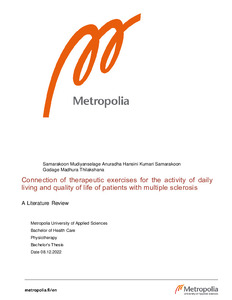Ecosystem restoration and zoonotic disease risk in humans : an integrative literature review
Leeson, Paul (2024)
Leeson, Paul
2024
All rights reserved. This publication is copyrighted. You may download, display and print it for Your own personal use. Commercial use is prohibited.
Julkaisun pysyvä osoite on
https://urn.fi/URN:NBN:fi:amk-2024102126579
https://urn.fi/URN:NBN:fi:amk-2024102126579
Tiivistelmä
The objective of this thesis was to conduct a review of the literature to investigate the links between ecosystem restoration and zoonotic disease risk in humans. This topic is relevant, as zoonotic disease is an increasing problem, and the UN’s Decade of Ecosystem Restoration was launched in 2021.
The main results found that ecosystem restoration especially in the tropics and forested wildness areas can prevent emerging infectious zoonotic diseases. The mechanism through which this is hypothesized to work is through strengthening ecosystem regulation of disease though high biodiversity mediated dilution effect and through the prevention of zoonotic disease spillover. Large scale ecosystem restoration is seen as a protective measure against a future zoonotic pandemic disease. High priority target areas are fragmented tropical forest habitats and the periphery of remaining primary forests and intact wilderness areas.
However, ecosystem restoration can also lead to the increase and spread of already known and endemic zoonotic diseases through increased wildlife resulting in higher animals to human transmission risk. The most researched example being the spread of Lymes Disease in Europe and North America. The mechanisms through which these are hypothesized to work is through an increase of available habitat resulting in increased abundance of wildlife and subsequent increased risk of transmission of zoonotic disease in humans. This problem is compounded by human induced trophic changes such as reduction or extermination of large apex predators such as wolves and bears which would otherwise keep deer and other wildlife populations in check, free of such top-down restraint’s deer, and other animal numbers are higher than they would be otherwise, resulting in high incidence of zoonotic disease. High at-risk areas identified for an increase of zoonotic disease because of ecosystem restoration are peri-urban and urban areas where high wildlife population densities would increase the risk of transmission of zoonotic disease through increased human-animal interactions.
The results of this thesis could be beneficial in designing ecosystem restoration projects which acknowledge the complex interactions between ecosystems and zoonotic disease and human health.
Keywords: ecosystem restoration, zoonotic disease, vector-borne disease
The main results found that ecosystem restoration especially in the tropics and forested wildness areas can prevent emerging infectious zoonotic diseases. The mechanism through which this is hypothesized to work is through strengthening ecosystem regulation of disease though high biodiversity mediated dilution effect and through the prevention of zoonotic disease spillover. Large scale ecosystem restoration is seen as a protective measure against a future zoonotic pandemic disease. High priority target areas are fragmented tropical forest habitats and the periphery of remaining primary forests and intact wilderness areas.
However, ecosystem restoration can also lead to the increase and spread of already known and endemic zoonotic diseases through increased wildlife resulting in higher animals to human transmission risk. The most researched example being the spread of Lymes Disease in Europe and North America. The mechanisms through which these are hypothesized to work is through an increase of available habitat resulting in increased abundance of wildlife and subsequent increased risk of transmission of zoonotic disease in humans. This problem is compounded by human induced trophic changes such as reduction or extermination of large apex predators such as wolves and bears which would otherwise keep deer and other wildlife populations in check, free of such top-down restraint’s deer, and other animal numbers are higher than they would be otherwise, resulting in high incidence of zoonotic disease. High at-risk areas identified for an increase of zoonotic disease because of ecosystem restoration are peri-urban and urban areas where high wildlife population densities would increase the risk of transmission of zoonotic disease through increased human-animal interactions.
The results of this thesis could be beneficial in designing ecosystem restoration projects which acknowledge the complex interactions between ecosystems and zoonotic disease and human health.
Keywords: ecosystem restoration, zoonotic disease, vector-borne disease
Kokoelmat
Samankaltainen aineisto
Näytetään aineisto, joilla on samankaltaisia nimekkeitä, tekijöitä tai asiasanoja.
-
Celiac disease among children in modern society : a literature review
Petrova, Daria (2022)Celiac disease is an autoimmune reaction of the small intestine to dietary gluten. This reaction manifests itself in the form of chronic inflammation in the intestine, due to which the villi on the intestinal wall are ... -
Nursing Care for Inflammatory Bowel Disease: Patient Support and Symptom Management – A Scoping Review
Saha, Joyanta Kumar; Khatoon, Jamila (2024)This research presents a scoping review focused on the role of nursing care in managing Inflammatory Bowel Disease (IBD), specifically Crohn's Disease and Ulcerative Colitis. The study aims to synthesize evidence on nursing ... -
Connection of therapeutic exercises for the activity of daily living and quality of life of patients with multiple sclerosis
Samarakoon, Anuradha Hansini Kumari; Godage, Madhura Thilakshana (2022)Multiple sclerosis is a progressive chronic disease of the brain and spinal cord. It is considered to be an autoimmune-mediated disease of the central nervous system, which causes chronic inflammation, primary demyelination ...



